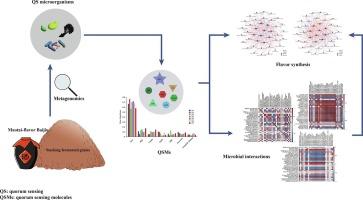Metagenomic insights into quorum sensing-associated microbial profiling and its correlations with flavor compounds of Maotai-flavor liquor: A case study of stacking fermented grains
IF 7
1区 农林科学
Q1 FOOD SCIENCE & TECHNOLOGY
引用次数: 0
Abstract
Stacking fermentation is typical process of Maotai-flavor Baijiu and microbial composition determine content of flavors. To date, the knowledge on the driving force of microbial composition was as yet unknown. Since quorum sensing molecule (QSM) plays an important role in modifying microbial interactions. Therefore, the objectives of the present study were: (1) to describe the microbial profile associated with QSM in stacking grains using metagenomics; (2) to elucidate how QSM shapes microbial interactions and accordingly regulates flavor synthesis. Results indicated that bacterial QSM including AI-2, DSF, and AHL as well as fungal QSM aromatic alcohols and farnesol were prevalent in the stacking fermented grains. Thereinto, AI-2 might be an important driving force of microbial composition due to its highest abundance. AI-2 in Limosilactobacillus fermentum, Pediococcus pentosaceus, and Weissella cibaria perhaps modified microbial interactions together with fungal QSM in Schizosaccharomyces pombe and Pichia membranifaciens. The role of AI-2 was much higher than that of fungal QSM. Furthermore, QSM indirectly influenced the synthesis of important flavors such as ethyl lactate, phenylethanol, and ethyl phenylacetate through the dynamic of microbial composition. Together, this current study for the first time explored the effects of QSM on microbial composition and flavor synthesis in the Baijiu field.

元基因组学对法定量感应相关微生物谱分析及其与茅台风味酒风味化合物相关性的洞察:谷物堆积发酵的案例研究
堆积发酵是茅台风味白酒的典型工艺,而微生物组成决定了风味的含量。迄今为止,人们对微生物组成的驱动力还一无所知。由于法定量感应分子(QSM)在改变微生物相互作用方面发挥着重要作用。因此,本研究的目标是(1) 利用元基因组学描述堆叠谷物中与 QSM 相关的微生物概况;(2) 阐明 QSM 如何影响微生物的相互作用,并相应地调节风味的合成。结果表明,堆积发酵谷物中普遍存在细菌 QSM(包括 AI-2、DSF 和 AHL)以及真菌 QSM(芳香醇和法尼醇)。因此,AI-2 可能是微生物组成的重要驱动力,因为其含量最高。发酵乳酸菌(Limosilactobacillus fermentum)、五味子球菌(Pediococcus pentosaceus)和西巴氏魏氏菌(Weissella cibaria)中的 AI-2 可能会改变微生物之间的相互作用,同时也会改变酿酒酵母(Schizosaccharomyces pombe)和膜葡萄孢(Pichia membranifaciens)中的真菌 QSM。AI-2 的作用远远高于真菌 QSM 的作用。此外,QSM 还通过微生物组成的动态变化间接影响重要香料(如乳酸乙酯、苯乙醇和苯乙酸乙酯)的合成。综上所述,本研究首次探讨了 QSM 对白酒领域微生物组成和风味合成的影响。
本文章由计算机程序翻译,如有差异,请以英文原文为准。
求助全文
约1分钟内获得全文
求助全文
来源期刊

Food Research International
工程技术-食品科技
CiteScore
12.50
自引率
7.40%
发文量
1183
审稿时长
79 days
期刊介绍:
Food Research International serves as a rapid dissemination platform for significant and impactful research in food science, technology, engineering, and nutrition. The journal focuses on publishing novel, high-quality, and high-impact review papers, original research papers, and letters to the editors across various disciplines in the science and technology of food. Additionally, it follows a policy of publishing special issues on topical and emergent subjects in food research or related areas. Selected, peer-reviewed papers from scientific meetings, workshops, and conferences on the science, technology, and engineering of foods are also featured in special issues.
 求助内容:
求助内容: 应助结果提醒方式:
应助结果提醒方式:


